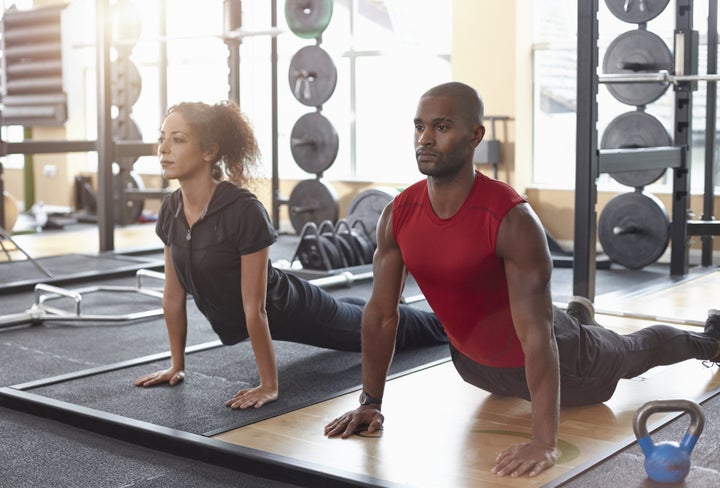Sometimes we can get so hung up on nailing our fitness goals, we don’t give our bodies enough time to recharge and recover.
High intensity workouts and getting PBs in your weights classes are all well and good, but going from that to a rest day can be pretty bad for your body.
While fitness classes in 2016 seemed to be dominated by pushing our bodies to the limits, this year people are recognising the need for exercise to recover.
Enter active recovery: Engaging in low-intensity exercise after high-intensity workout sessions - something we should all be doing regularly.
“Research has shown that doing nothing may not be the best way to recover and therefore may negatively impact the very adaptation we were trying to achieve by exercising in the first place,” Jonathon Lomax, founder of Lomax Gym told HuffPost UK.

What is active recovery?
David Kingsbury, who specialises in muscle symmetry, postural control and core strength at OPUS Fitness said we should look at it as the “time between” our workouts.
So a rest day is complete rest, where no physical activity is completed, but active recovery is a short, low-intensity workout that aims to increase blood flow, metabolism and joint movement.
According to Lomax, there are two forms of active recovery: one is during the cool-down phase immediately after a hard effort or workout; the second includes the days following an intense workout.
“Active recovery focuses on completing a ‘workout’ or series of activities at a level that is just high enough that it gets the blood moving in order to help reduce residual fatigue in the muscles to repair and prepare for the intense activity to follow,” added Lomax.
At Lomax, they run a “supple circuit” where you learn to move more efficiently. It’s a combination of foam rolling, resistance bands and using TRX to mobilise and activate your body for upcoming exercise.
The class aims to improve performance across the board - an essential part of anyone’s training plan.
Why is it important?
Physiotherapist Paul Bryce, who runs Midlothian Physiotherapy LLP and is JimJam’s Clinical Director said during exercise, our muscles (made up of tiny fibres) change in response to our demands.
When we are exercising, our muscles work in two ways: shortening (called ‘concentric contraction’) and lengthening (’eccentric contraction’). During this, the muscle fibres can be subject to damage.
Active recovery helps the muscles recover from this damage and helps them adapt to the demands placed on it.
He explained: “This is enormously beneficial when individuals are trying to achieve specific training goals - ultimately helping you grow stronger. It helps the circulatory system remove the chemical by-products of cellular activity during a workout.”

How shall I do it?
Kingsbury said it can often be a good idea to complete a light training session between key workouts to raise your metabolism and calorie loss further, without inhibiting the ability of the muscles to repair.
Let’s take legs as an example. Following a resistance workout, the muscles in the legs are likely to be sore and stiff the following day.
Rather than resting completely and losing a days’ worth of training, Kingsbury said an active recovery session may include a light cycle, or 30 minutes on the cross trainer at a low intensity. This allows the blood to flow through the muscles – helping to accelerate the healing process and reduce the associated muscle soreness.
But he said, due to the ever growing dynamic fitness scene in London, more people complete a version of active recovery than they realise. With a countless number of classes such as boxing, Pilates, HIIT, yoga, barre and spinning on offer, many choose to vary their workouts based upon the intensity, duration and type of training.
“The devoted cycling enthusiast for example, may choose to break up the training week by completing a yoga class in between long distance cycles, to develop flexibility and mental relaxation,” he said.
“In this case, the body is being challenged in a different way, at a much lesser intensity.”

How often should you do it?
Lomax said ideally we should try and move everyday, but advises people to break their active recovery sessions up into groups like you would your training – i.e. leg day, chest day, back day, core and abs, and cardio.
By the end of the week you will have worked through your whole body, improved performance, posture and probably stress levels, too.
If you are really pressed for time, you can include your recovery activities into your workouts, at the beginning, end or during your workout as supersets.
“I am a fan of this and I use movements from the ‘animal flow’ world like lizard walks, crab grabs and beast reaches straight after my squats, chin-ups or bench press, which has the added metabolic bonus of driving up my heart rate,” said Lomax.
Active recovery is however best done on days you traditionally don’t do anything you see as exercise, because it is rehabilitating your already-stressed body.
“The other reason is mental,” said Lomax. “Saving these short, low-intensity sessions for days off the gym, combats the anxiety that many of us (including athletes) get from not exercising.
“Rather than getting stressed because you didn’t get your HIIT endorphin release, you can focus on the positive fact that even 10 minutes of this work will allow you to get more out of your workouts when you do make it to the gym or take down that 10k at the weekend.
“Not doing this stuff will eventually mean you will start to underperform or worse, get injured, which will leave you unable to exercise for longer periods of time.”
Other ideas for active recovery include:
Swimming: a zero-impact sport which will increase joint range of motion and increase blood flow to recovering muscles.
Cycling: another low-impact activity which can increase metabolic demand whilst allowing muscular recovery.
Stretching: using rest days to improve muscular flexibility is highly recommended – especially if your workouts are often rushed and your stretching routine is neglected.